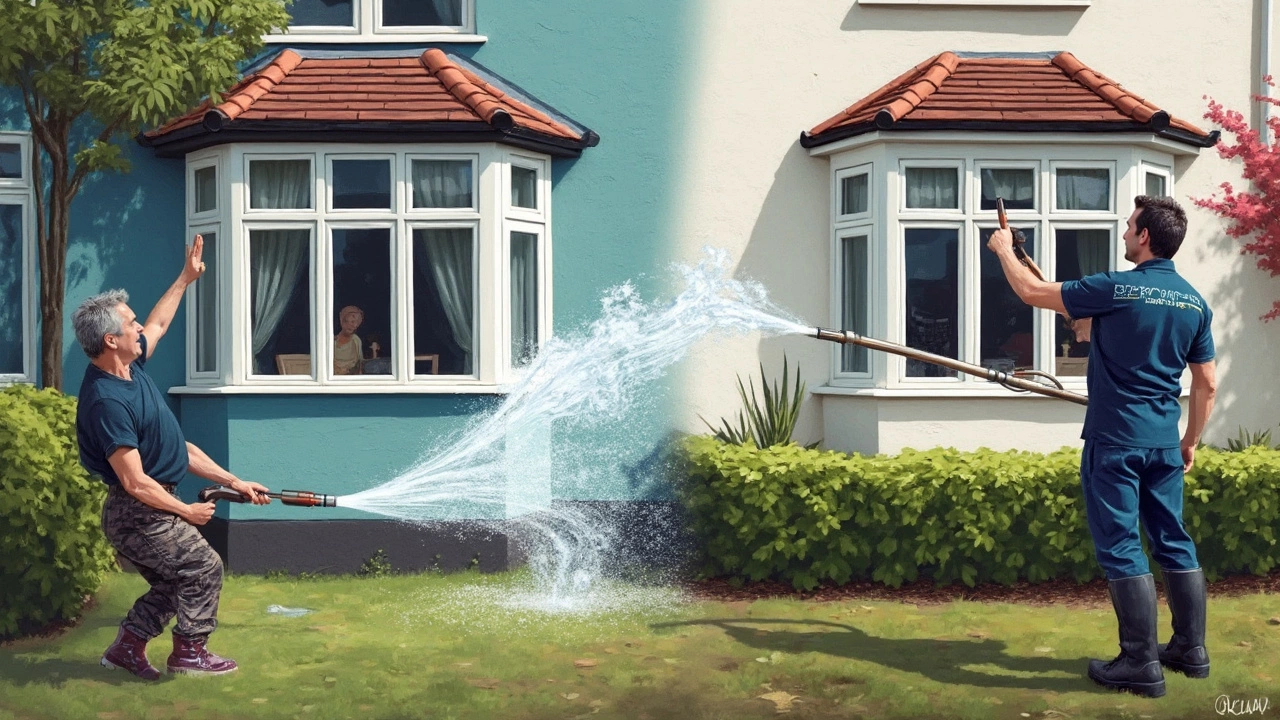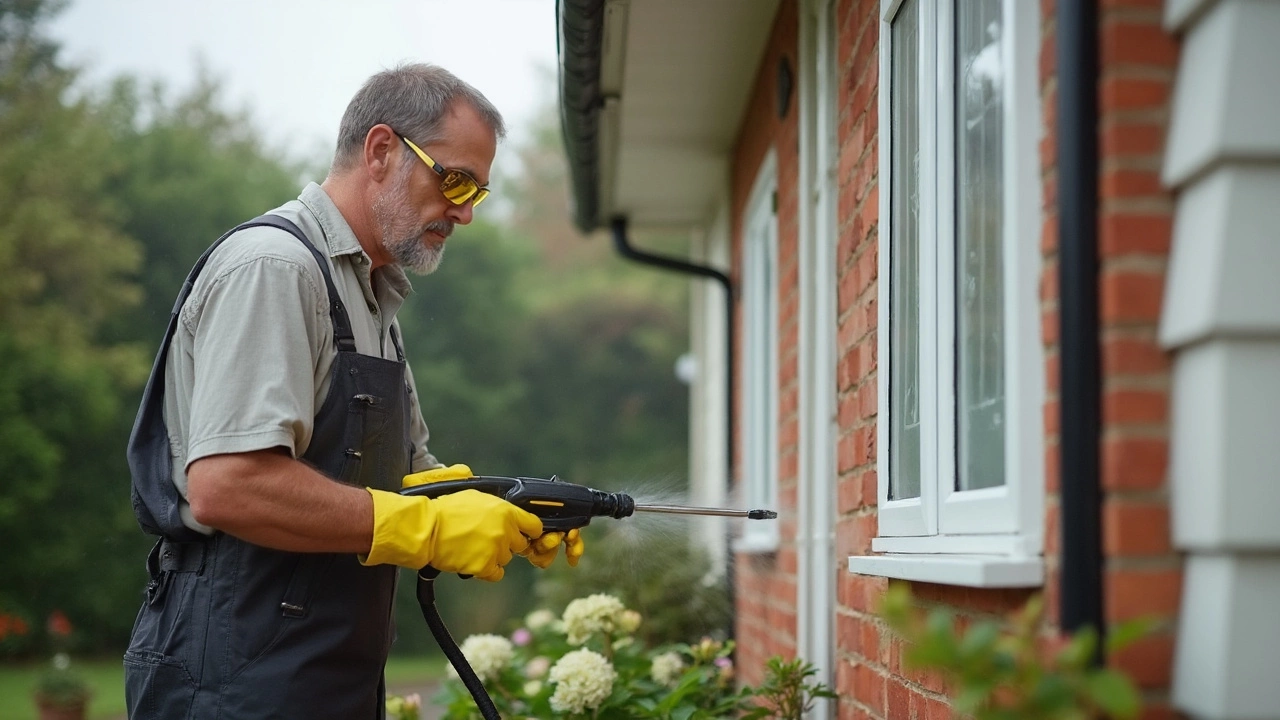Pressure washers look like the quickest way to turn a dirty siding into something you’ll actually be proud of. But is it really a good idea to point all that power at your vinyl siding? People mess this up all the time and end up with water behind the walls or chunks of siding on the ground.
If you’re itching to blast away grime, you should know: vinyl seems tough, but it’s actually easier to damage than you’d think. Hit it with too much force, or use the wrong angle, and you can crack panels or force water into places it shouldn’t go. Water that sneaks behind the siding may quietly rot the wood and invite mold. The best approach isn’t just about cleaning power—it’s about control. Ready for the details? Let’s dig in.
- What Happens When You Pressure Wash Vinyl Siding
- Common Pressure Washing Mistakes
- Safe Methods and Smart Tips
- When to Call a Pro
What Happens When You Pressure Wash Vinyl Siding
Pressure washing looks like the simplest way to clean your vinyl siding fast, but a lot happens when that powerful stream hits your house. At first, you’ll see dirt, mold, and algae blast away in seconds. Your home goes from dingy to fresh without much scrubbing. That’s the upside people love about pressure washing.
Here’s the catch with vinyl: it’s a pretty sturdy material, but it’s not meant to handle crazy high pressure. Most vinyl siding is designed to handle water running down it, not water driven straight at it at 2,000+ PSI. If you crank up your pressure washer too high, you could force water up and behind the panels. That’s risky—trapped moisture leads to wood rot, mold, and even bugs behind your walls. According to the Vinyl Siding Institute, water pressure above 1,500 PSI can start to loosen or crack panels if you’re not careful.
People also make the mistake of spraying straight upwards. That can drive water every place it doesn’t belong. You might not see damage right away, but a year later you could be fighting off a musty smell in your house or warped sheathing.
Let’s see how these problems stack up compared to the benefits:
| Pressure Level (PSI) | Cleaning Power | Risk of Damage |
|---|---|---|
| Below 1,500 PSI | Removes dirt, light stains | Low, safe for most vinyl |
| 1,500-2,500 PSI | Removes tough grime, molds | Moderate, watch for cracks |
| Over 2,500 PSI | Blasts tough stains fast | High, can crack or warp siding |
The pressure washing process can also strip away siding coatings and fade color if you do it often. In rare cases, folks have actually blasted siding right off the wall. That’s why pros always stick to lower pressures and the right angle—spraying down, not up. If you follow the right technique, your siding stays clean and you skip all the problems. But if you rush or grab the turbo nozzle, you could end up with way more work than you started with.
Common Pressure Washing Mistakes
Pressure washing vinyl siding sounds easy—squeeze the trigger and watch the dirt fly. But plenty of people fall into some classic traps that trash their siding or even cause water damage inside the walls.
The biggest fail? Cranking up the pressure. Most home pressure washers go up to 3,100 PSI, but vinyl siding is only built to take about 1,300–1,600 PSI before it starts softening, bending, or cracking. Blast it harder, and you’re asking for a bill from the siding guy. Another mistake is spraying up under the siding panels. This shoots water behind the boards, which is a surefire way to start rot and mold problems you probably won’t catch until it’s way too late.
Folks also skip over the right attachments, thinking any spray tip works. The “zero-degree” tip fires water in a pinpoint—think carving a line through butter. It’s way too harsh for siding, and it leaves streaks, gouges, or holes. The safer bet is a 25-degree or 40-degree tip, which spreads out the blast.
- Don’t pressure wash with hot water; it can warp or discolor vinyl.
- Don’t hold the nozzle too close—keep it at least 12–18 inches away from the surface.
- Don’t ignore the manufacturer’s siding care guide. It often warns about power washing.
- Don’t forget to test a small, hidden patch first. Better to mess up where nobody will see.
Check out how these mistakes stack up in terms of risk:
| Mistake | Common Outcome | % Homeowners Affected (Survey 2023) |
|---|---|---|
| Too high pressure | Cracks, dents, broken panels | 32% |
| Wrong spray angle (under panels) | Water intrusion, mold inside walls | 21% |
| Wrong nozzle tip | Streaks, etching marks | 28% |
| Too close to the surface | Holes, warping | 16% |
The safest move is to slow down and work methodically, always keeping that pressure washing wand aimed straight at the siding—never up, never too close, and always with the right tip in place.

Safe Methods and Smart Tips
You can pressure wash vinyl siding safely, but you've got to keep things under control. Don't just crank up the pressure and hope for the best, unless you want holes in your siding or leaks behind the boards. Here’s how to do it the right way so you get results without the mess or damage.
- Pressure washing is best kept under 1,500 psi for vinyl siding. Most pros stick with 1,200 to 1,400 psi. Crank it higher, and you’re just asking for warped panels or broken seals.
- Always use a wide spray nozzle—think 25- or 40-degree tip. The tighter the spray, the more likely you’ll damage the siding. Wider tips spread out the pressure, keeping things safe and even.
Keep the spray at or above eye level, and aim straight at the panel, not up or down. Spraying upward lets water sneak behind the siding, which is a recipe for rot and mold down the road. Keep at least a foot away—don’t get right up against the surface or you’ll find out just how flimsy vinyl can really be.
- Rinse off any loose dirt with a garden hose first. Pressure washing works best when it’s just tackling the stuck-on grime, not mud chunks or leaves.
- Mix up a simple cleaner. Most folks swear by a mix of water, a tiny bit of dish soap, plus a dash of white vinegar for mildew.
- Apply soap on a low-pressure setting or with a separate attachment, starting at the bottom and working up. This helps avoid streaks.
- Let the suds sit for a few minutes, but don’t let them dry. Rinse off from top to bottom with low to medium pressure.
One extra tip: watch nearby outlets, windows, and vents. Tape down anything you don’t want water blasting into, and cover electric stuff with plastic. Want less risk? Try a soft wash method—a regular garden sprayer followed by a gentle rinse.
If you feel nervous or your house is extra tall, it's totally fine to call a pro. They’ve got the gear to clean siding fast, and they won’t wreck your siding in the process.
When to Call a Pro
There are times when tackling vinyl siding with your own pressure washing gear is just asking for trouble. If your siding is two stories up and you’re nervous on a ladder, skip the heroics—it’s not worth risking a fall just to have cleaner walls.
Noticed green or black patches that don’t budge even after scrubbing? Stubborn mildew or algae, especially in shaded or damp spots, sometimes needs more than a DIY washing. Pros have the right cleaners and know how to kill the growth without damaging your siding or landscaping. As a bonus, most professional teams carry insurance if anything goes sideways.
Here are signs that you should hand it off to the professionals instead of toughing it out:
- Your siding is really old, brittle, or already damaged.
- You see loose or warped panels before starting.
- Your home has multiple stories or awkward angles that you can’t safely reach.
- You spot signs of rot, mold, or bug infestation behind or around the siding.
- You don’t know what setting or tip to use on your pressure washer—or you’re borrowing gear and just guessing.
As John Paul, a certified exterior cleaning contractor from Clean Home Network, puts it:
“Replacing a few broken panels or fixing hidden water damage is way more expensive than hiring someone who’s done this a thousand times.”
Hiring a pro can also save you time and headaches. They typically finish the job faster, avoid streaks and patchy spots, and clean up after themselves. If you’ve got delicate landscaping, pro washers usually shield your plants and rinse everything down so nothing wilts or gets stained. At the end of the day, think about what you’re comfortable with—and don’t be afraid to pick up the phone if the job looks like more than you expected.
